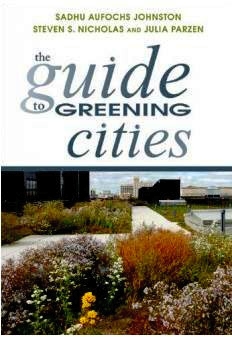City sustainability leaders share their successes in The Guide to Greening Cities

Posted December 2, 2013 at 1:31PM
One of the most encouraging recent trends in municipal government has been the adoption of sustainability as a critical part of the urban agenda. The list of cities claiming to have the highest aspirations for greenness is growing and now includes, for example, Vancouver (“we will . . . make us the greenest city in the world”), Philadelphia (“In order to make Philadelphia the greenest city in America . . .”), San Francisco (“I believe we were named the greenest city in North America because . . .”), Chicago (“the City aims to make Chicago the nation’s greenest city”), and Washington, DC (“a path forward to make the District the healthiest, greenest, most livable city in the nation over the next 20 years”), undoubtedly among others. Few places were even talking about these issues a decade ago. These ambitions deserve our applause.
Moreover, cities are not just laying out their ambitions: they are creating administrative structures to implement them. The Urban Sustainability Directors Network, an informal organization of local government leaders engaging in collaboration, peer-to-peer support and information-sharing, now has 120 members working in cities across the US. The Network also houses eight regional sub-networks and disburses a pool of philanthropic funds to support particularly significant or innovative practices.
Some of these practices are now detailed in a new book, The Guide to Greening Cities, authored by three leaders of the Sustainability Directors Network including Julia Parzen, the group’s founding executive director. There is also a companion website.
I was pleased to see some of my favorite projects profiled in the book, including the remarkable Plan El Paso, one of the best-articulated blueprints for sustainable growth and development I have ever read. It also describes Philadelphia’s ambitious plan to use green roofs, green streets, and other innovative green infrastructure to clean its waterways while bringing nature into the city; and it highlights Denver’s efforts to build affordable housing along its light rail network, which includes the stellar Mariposa development.
As far as I know, The Guide to Greening Cities is the first book written primarily from the perspective of municipal sustainability officials, sharing their on-the-ground experience working to advance green city goals. As such, it explains the story of government leadership from the inside and, importantly for readers, at the level of practitioners rather than politicians. It’s easy to forget that the maze of government bureaucracy can be just as daunting to those seeking change from within as it is to those of us on the outside. As a result, the Guide is really useful to advocates who need to understand how the bureaucracy works in order to be influential.
 For example, in the section on Philadelphia’s program for green infrastructure, you’ll find wisdom on such tricky issues as managing expectations, building a supportive culture, investing in improvements that can win public support, and creating “performance metrics that drive learning and adaptation.” Other particularly illuminating case studies include assessing climate resilience in Flagstaff and promoting green alleys in Chicago. There is a chapter on performance indicators, too, focusing on Minneapolis and New York City (I highlighted a particularly impressive set for Rockford, Illinois, here).
For example, in the section on Philadelphia’s program for green infrastructure, you’ll find wisdom on such tricky issues as managing expectations, building a supportive culture, investing in improvements that can win public support, and creating “performance metrics that drive learning and adaptation.” Other particularly illuminating case studies include assessing climate resilience in Flagstaff and promoting green alleys in Chicago. There is a chapter on performance indicators, too, focusing on Minneapolis and New York City (I highlighted a particularly impressive set for Rockford, Illinois, here).
You can also learn from efforts in these cities and places such as Raleigh, Asheville and San Antonio, about greening city operations; the art of partnerships and persuasion; leadership; and budgeting, financing, and economic development. Think of the book as a peek inside the machinations of local government and a guide to Getting Things Done, pragmatically yet with vision. The book's companion website offers more, including video interviews with 20 leaders from around the country about their work. The Sustainability Directors’ website also offers a range of resources, including the very intriguing-sounding “Triple Bottomline Calculator,” to help quantify the economic, environmental and social return on investment for specific projects.
I often argue that environmentalists should see cities as the solution, not the problem, when it comes to sustainability. But making good on that claim requires leadership, stewardship and vigilance. This book documents the successes of some dedicated professionals who are doing just that, and I plan on keeping it close at hand.
Daryl Young of the Summit Foundation has been involved with the Urban Sustainability Directors Network since the beginning. In less than a minute, he summarizes what these efforts are all about:
Related posts:
- 13 photos and 11 simple thoughts for greener, healthier cities (July 8, 2013)
- The essential elements of green cities (by Lee Epstein) (April 3, 2013)
- Cities and the ecology of "people habitat" (March 27, 2013)
- David Dixon, leader of 2013's top city planning firm, on what makes cities great (March 12, 2013)
- From elephant to estuary: does the 2013 European Green Capital have something to teach US cities? (December 17, 2012)
- Tools to help cities and towns guide green development (March 7, 2012)
- Seeing cities as the environmental solution, not the problem (August 9, 2011)
Move your cursor over the images for credit information.
.

